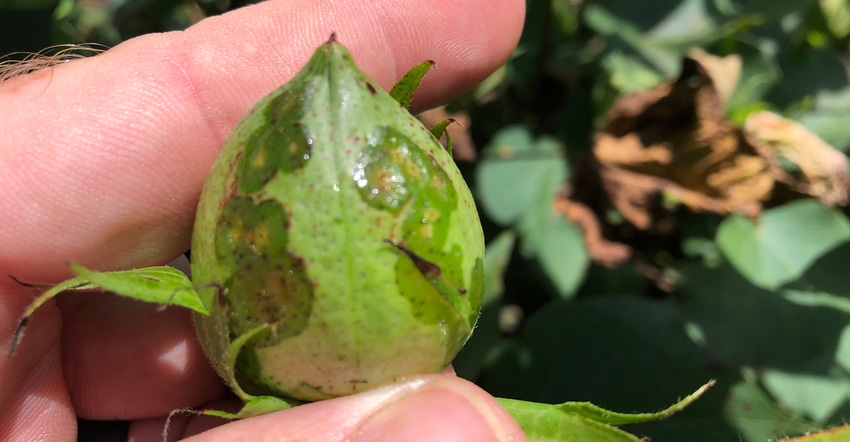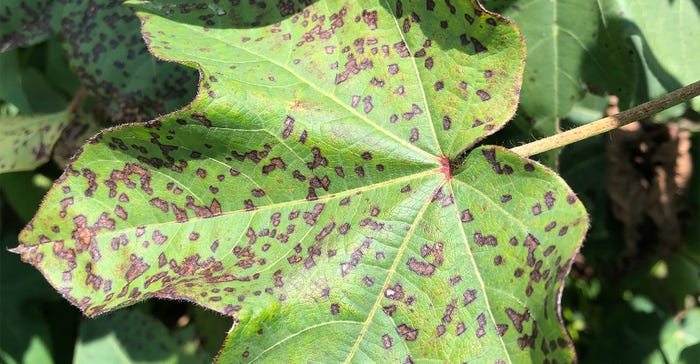
In 2011, an outbreak of cotton bacterial blight in Mississippi was the catalyst for a team of Mississippi State University researchers to create a rapid test to detect the disease in cottonseed.
Once bacterial blight is observed in a field, there are no management practices to reduce the amount of the disease present. The best way to manage bacterial blight is to choose a resistant variety, an important decision made before the seed goes into the ground.
Two MAFES scientists, Tom Allen, MSU Extension and research plant pathologist, and Shien Lu, MSU professor specializing in plant bacteriology, developed the test, along with their research team, to detect the bacterial pathogen that causes bacterial blight of cotton. Their research, funded by Cotton Inc., is now available for the National Plant Diagnostic Network laboratories to use as well as major U.S. planting seed companies.
The history of cotton blight
Cotton bacterial blight is a cotton disease of historical importance first identified in the 1890s and has been problematic for farmers periodically for years. From the 1930s through the 1950s, bacterial blight was widespread in the United States. However, in the 1970s, the incidence of bacterial blight was reduced in part as a result of acid delinting cottonseed.
"One of the more difficult parts about this disease is, since it is a foliar disease, the organism can survive for short periods on residue between seasons," Allen said. "Hypothetically, a farmer plants a bacterial blight-susceptible cotton variety, has bacterial blight, harvests the crop, and shreds the cotton stalks. The shredded stalks remain on the soil surface and cotton is planted the following year. If a susceptible variety is planted again, the residue from the previous season could contribute to the disease anew. However, that is just one way the disease can be initiated. Residue is not the most important source of the organism."
If the cotton stalks were shredded and the residue buried with some form of tillage, typically, the amount of the inoculum that can survive between seasons is greatly reduced.
"The organism that causes bacterial blight is a weak competitor," he said. "It cannot generally survive with the additional organisms present in soil because they will break down the residue, so you lose a potential source of inoculum. Even though residue can serve as an inoculum source, one of the main sources of the organism to initiate the disease is on infested seed."
Susceptible varieties can harbor a tremendous amount of the bacterium that causes bacterial blight if there was an infection in the field where planting seed originated.
"Bacterial blight has to have occurred in a seed production field for there to be an issue with the subsequent seed," Allen said.
In the 1960s, seed companies started breeding for resistance to bacterial blight. Also, bacterial blight was one of the main reasons the industry started acid delinting cottonseed in the 1970s, which helped reduce the disease, but not eliminate it.
"Currently, there are a lot of resistant varieties available," he said. "The hard part is some of the more bacterial blight-susceptible varieties can produce a high yield. A lot of cotton farmers still gravitate toward choosing those varieties because they do produce such good yields even at the risk of the disease.
"In 2011, we had a huge outbreak of bacterial blight. Minimal reports of bacterial blight had occurred in Mississippi before 2011. In general, bacterial blight is a disease you can pretty much find just about every year if you look hard enough, but generally speaking, on an annual basis, small instances occur that tend to be geographically isolated. In 2011, we had bacterial blight all over the north Delta and into parts of east Mississippi."
From 2012 to 2013, the research team started doing some initial testing for the bacterium in seed.
"I identified places where we observed the disease to provide Dr. Lu some infected leaf material and bolls, so he could remove seed from those and screen for the bacterium," Allen said. "That is how we initiated the project to develop a more rapid screening technique to detect the bacterium in seed."

Detecting the disease in seed
The hardest part about screening for bacterial blight in cottonseed from a historical standpoint, before the development of the test created by the MSU team, involved a laborious process that would require several days in the laboratory.
"Cotton bacterial blight is caused by a bacterial pathogen, which is called Xanthomonas citri pv. malvacearum (Xcm)," Lu said. "This disease used to be a bigger problem in the southern part of the United States in the early 1900s. However, in 2011, the disease was observed across a large part of Mississippi."
The key challenge of the project was how to detect the pathogen from seed.
"The first step of the research was to search for detection methods," he said. "For example, we are currently suffering from COVID-19. In addition to COVID-19, there are multiple viruses such as HIV, flu, and the common cold, and one person could carry multiple viruses. How can you detect one specific virus? Or, in our case, how can you detect a specific bacterium from a plant?"
"When we know the genetic composition, we can develop an Xcm-specific detection method just like for COVID-19. Scientists used PCR-based technology to design the COVID-19 specific primer to detect the virus. Likewise, we designed primers and a probe using the unique genetic makeup of the bacterium that causes bacterial blight from a genetic DNA fragment of Xcm. From there, we designed the quantitative PCR protocol."
This reduced the amount of time and labor required to test for the pathogen. The team created the molecular test and have provided the specific protocol in a cookbook fashion, so anybody with the right tools can conduct the test in their laboratory.
"The purpose of this protocol is so we can detect the pathogen from a seed sample even though the sample could contain several different bacteria," Lu said. "We can target the specific pathogen and determine if the organism that causes bacterial blight is present or not. The resulting protocol can be used by the industry, seed companies, or seed testing laboratories to detect the organism in quantities as low as 10 bacterial cells from a single sample of seed."
This technology is important to the industry to allow companies a way to test seeds for the bacterium. That way, seed is not unintentionally carrying the bacteria into the field, and farmers do not experience yield losses associated with the disease.
"By being able to detect the bacteria in the seed stage," Lu said, "I believe this technology helps us to fight back bacterial blight in cotton and will protect our cotton production industries here in the U.S. as well as other countries."
About the Author(s)
You May Also Like




